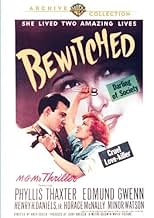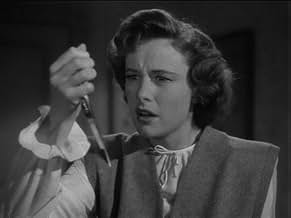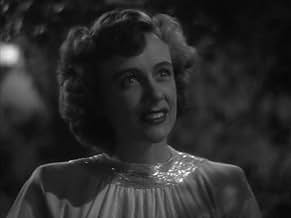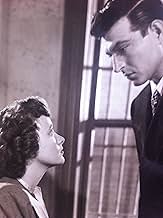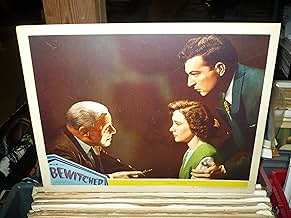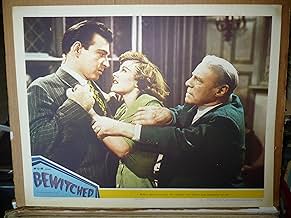AVALIAÇÃO DA IMDb
5,6/10
699
SUA AVALIAÇÃO
Adicionar um enredo no seu idiomaA young woman has two distinct personalities, one of whom is evil and constantly gets her in trouble.A young woman has two distinct personalities, one of whom is evil and constantly gets her in trouble.A young woman has two distinct personalities, one of whom is evil and constantly gets her in trouble.
Stephen McNally
- Eric Russell
- (as Horace McNally)
Tom Coleman
- Juror
- (não creditado)
Clancy Cooper
- Cop
- (não creditado)
Eddie Dunn
- Prison Janitor
- (não creditado)
George Meader
- Juror
- (não creditado)
Howard M. Mitchell
- Juror
- (não creditado)
Avaliações em destaque
Wholesome gal Phyllis Thaxter lives with her upper-middle-class parents and plans to wed soon. But she's beginning to cause some concern; she's prone to odd fainting spells blackouts, really and to wandering the deserted streets of her midwestern city at night. Scant wonder, because living inside her, and clawing to get out, is Audrey Totter! Totter, in fact, gives perhaps the most chilling voice-of-the-demon performance until Mercedes McCambridge gave us Pazuzu in The Exorcist.
Capitalizing on the heightened interest in abnormal psychology spurred by the return of shell-shocked veterans, Bewitched latches onto a tabloid-worthy subject multiple personality disorder. It's noteworthy in doing so a dozen years before both Lizzie and The Three Faces of Eve, in which, respectively, Eleanor Parker and Joanne Woodward (who nabbed the Oscar) displayed similar symptoms. Footnotes in medical journals probably do not cite any of these movies, so facile is their treatment of a troubling and controversial syndrome.
Thaxter tries a geographical cure, fleeing to New York where she falls in love with a lawyer (Stephen McNally). But when her old fiancé tracks her down, Totter, who apparently wasn't left behind, emerges to kill him with a pair of scissors. Then comes a stylized courtroom fantasy lifted all but intact from Boris Ingster's Stranger On The Third Floor, followed by a real murder trial. Wise old psychiatrist Edmund Gwynne explains everything to us, along with the Governor and his wife, and then proceeds to exorcize Totter (who, by the way, calls herself Karen).
Apart from Thaxter's nocturnal excursion, there's little original or striking about the movie. That we see the good girl but only hear the bad one is a big part of the problem. The extra energy that might have come from seeing Karen in action for that matter, from casting Totter on-screen gets thrown away. They picked the wrong personality.
Capitalizing on the heightened interest in abnormal psychology spurred by the return of shell-shocked veterans, Bewitched latches onto a tabloid-worthy subject multiple personality disorder. It's noteworthy in doing so a dozen years before both Lizzie and The Three Faces of Eve, in which, respectively, Eleanor Parker and Joanne Woodward (who nabbed the Oscar) displayed similar symptoms. Footnotes in medical journals probably do not cite any of these movies, so facile is their treatment of a troubling and controversial syndrome.
Thaxter tries a geographical cure, fleeing to New York where she falls in love with a lawyer (Stephen McNally). But when her old fiancé tracks her down, Totter, who apparently wasn't left behind, emerges to kill him with a pair of scissors. Then comes a stylized courtroom fantasy lifted all but intact from Boris Ingster's Stranger On The Third Floor, followed by a real murder trial. Wise old psychiatrist Edmund Gwynne explains everything to us, along with the Governor and his wife, and then proceeds to exorcize Totter (who, by the way, calls herself Karen).
Apart from Thaxter's nocturnal excursion, there's little original or striking about the movie. That we see the good girl but only hear the bad one is a big part of the problem. The extra energy that might have come from seeing Karen in action for that matter, from casting Totter on-screen gets thrown away. They picked the wrong personality.
No need to repeat the plot. The force behind the movie is Arch Oboler, an established radio heavyweight at the time. From his credits, it looks like he kept searching for a handle in Hollywood but never quite found it. Certainly, it wasn't from lack of imagination—his 1951 film "Five" dealt with nuclear post-apocalypse in a resourceful and compelling way at a time when no studio would touch the subject. That same bold imagination is evident in this movie as well. The professionals dismiss the film as "heavy-handed", which it is. However, there are compensations that are too easily overlooked.
Aside from Thaxter's fine performance, the movie contains several profoundly imaginative touches. Catch that moody dollying shot down the deserted city street that finally fixes on a cringing Thaxter hiding behind an open doorway. Not only is it great atmosphere, but it also sort of sums up Thaxter's predicament. She's afraid to come out into the world for risk of immediate exposure, so she clings fearfully to a hidden world where only she exists. It's a well-conceived and artfully executed passage. Then there's that darn-near sublime set-up with Thaxter huddled in a concert hallway while we see a long-shot of a vocalist pinpointed by a thin beam of light. The woman intones a mournful version of My Old Kentucky Home, like the proverbial voice in the darkened wilderness. It may be the only glimpse we get of Thaxter's true inner self, summed up poetically.
But the overly literal side does unfortunately predominate, and I wish someone had more confidence in audience imagination. For one thing, that would have eliminated the two hokey doppelgangers in the exorcism scene. Also, the conventional happy ending is much too pat for the problem being dealt with, but is indicative of the time. And if I'm not mistaken, there's a quick reference from Gwenn to Thaxter's problem as being genetic, as if a multiple personality trait can be passed along in the genes. I'm no clinical psychologist, but I doubt seriously this is the prevailing view. Anyway, it's too bad Oboler couldn't get a better handle on Hollywood. I think his credits showed genuine promise. This movie may be unfortunately flawed (perhaps because of studio dictates), but the very real compensations should not be overlooked.
Aside from Thaxter's fine performance, the movie contains several profoundly imaginative touches. Catch that moody dollying shot down the deserted city street that finally fixes on a cringing Thaxter hiding behind an open doorway. Not only is it great atmosphere, but it also sort of sums up Thaxter's predicament. She's afraid to come out into the world for risk of immediate exposure, so she clings fearfully to a hidden world where only she exists. It's a well-conceived and artfully executed passage. Then there's that darn-near sublime set-up with Thaxter huddled in a concert hallway while we see a long-shot of a vocalist pinpointed by a thin beam of light. The woman intones a mournful version of My Old Kentucky Home, like the proverbial voice in the darkened wilderness. It may be the only glimpse we get of Thaxter's true inner self, summed up poetically.
But the overly literal side does unfortunately predominate, and I wish someone had more confidence in audience imagination. For one thing, that would have eliminated the two hokey doppelgangers in the exorcism scene. Also, the conventional happy ending is much too pat for the problem being dealt with, but is indicative of the time. And if I'm not mistaken, there's a quick reference from Gwenn to Thaxter's problem as being genetic, as if a multiple personality trait can be passed along in the genes. I'm no clinical psychologist, but I doubt seriously this is the prevailing view. Anyway, it's too bad Oboler couldn't get a better handle on Hollywood. I think his credits showed genuine promise. This movie may be unfortunately flawed (perhaps because of studio dictates), but the very real compensations should not be overlooked.
Average yet enteraining story about a young girl being plagued with a voice inside telling her what to do. The girl breaks down and listens to the voice, moving across country leaving her family and fiancée behind to make a new start. The film then has a new man come into the girl's life when old wounds are re-opened and tragedy strikes. While nothing particularly inventive takes place, I rather liked the mood created throughout the film. The film opens with the female protagonist in jail for a crime she didn't yet did commit. Phyllis Thaxter as Joan, the troubled young lady with multiple personalities living inside her, gives a more than competent portrayal of this tortured woman, yet the film's story is rather weak and completely falls apart in the last third when some ridiculous scientific explanation is given for her aberrant behaviour. Edmund Gwenn plays a psychiatrist/family friend and gives the film a bit of credibility with his performance. The rest of the cast is adequate and the film is mildly entertaining. Hypnosis, the gas chamber, and playing with scissors are all explored.
When I saw this excellent little B thriller, I could not prevent me to think of THREE FACES OF EVE, the Nunnaly Johnson's masterpiece. Very close plot, topic, but this one is unfortunately unknown, underrated, except maybe for the die hard moviegoers. It is a Metro Goldwyn Mayer's movie - at least for the release - and the lead character played by Phillis Thaxter is absolutely perfect in this very difficult role of this young woman suffering of a multiple personality disorder. But both features are quite different though, this one is more eerie and less complex in the psychological, psychoanalytic than the movie starring Joanne Woodward. Arch Oboler leaves here his trade mark, making something different, offbeat. A cute little gem.
Bewitched is written and directed by Arch Oboler. It stars Phyllis Thaxter, Edmund Gwenn, Henry H. Daniels, Addison Richards, Horace McNally and Kathleen Lockhart. Music is by Bronislau Kaper and cinematography by Charles Salerno Jr.
One of the most interesting of splinters to come out of film noir was that which dealt with psychoanalysis. Be it mentally scarred war veterans, amnesia sufferers with locked in repression, or a victim being pushed to the mental abyss by an outside force, the state of mind factor was ripe for any sort of film noir sheen.
What was under represented were films that dealt with mental illness' like schizophrenia or multiple (split) personalities. History tells us that Hollywood took a long time to get to grips with such topics, very much resorting to guesswork (and sometimes laughable) solutions to mental health issues just to close out the movies with a happy outcome.
It would take until 1957 and Three Faces of Eve (and to a lesser extent Hugo Haas' Lizzie released the same year) for the personality disorder issue to break out of Hollywood and into the public conscious. But even then with "Eve", if you take out Joanne Woodward's spell binding performance you are left with some mumbo-jumbo and a daft resolution to the curing of the patient.
So where does this leave Bewitched in 1945? Transferred from radio to the big screen by Oboler, from his own story titled Alter Ego, Bewitched suffers from the same simplified problems of so many like minded sub-genre movies, in that the resolution ("cure") is just so hard to get on board with. However...
If allowing the film some grace for the time it was made, then there's a very good picture here. Clocking in at just over an hour, it certainly feels and plays like one of those extended episodes of The Twilight Zone from Season 4, but the atmospherics and lead performances of cast members ensure this is fascinating and suspenseful entertainment.
Plot essentially sees Thaxter as troubled Joan Alris Ellis, who after starting to hear a sinister voice in her head (voiced by noir darling Audrey Totter), flees to New York to start afresh, leaving behind family and her intended husband to be. After becoming involved in a warm relationship with Eric Russell (McNally), Joan finds that the voice, her alter ego, is not going to go away and urges Joan to commit murder.
Pic unfolds in a flashback structure, Joan is awaiting execution and we learn how she came to be in this situation. Oboler and Salerno film the piece through a film noir prism, ensuring that a disquiet mood is prevalent throughout. As the lens' mist up and shadows fall (99% of film is set in darkness or daylight as darkness), the visuals marry up nicely with poor Joan's befuddlement.
Oboler is guilty of letting the piece meander at times, as it often becomes over talky (the radio origins practically scream from the speakers!), but he has a very sharp eye for an evocative scene, and he's also capable of telling tech flourishes. Joan running down a street lit by bulbous lamps is straight out of noirville, distorted angles come and go, and clocks feature prominently, like Old Nick is right there counting down the seconds on every clock face.
Then it's that resolution. Simplified for sure, but not without eeriness personified as Joan's femme fatale alter ego arrives on the scene in a clear case of angel and demon perched on either side of the hapless patient. With Thaxter excelling with her haunted portrayal, Gwenn exuding assurance unbound, and Kaper (Gaslight) drifting a creeping menace like musical score over the proceedings, the impact garnered belies the "B" budget afforded the play. 7.5/10
One of the most interesting of splinters to come out of film noir was that which dealt with psychoanalysis. Be it mentally scarred war veterans, amnesia sufferers with locked in repression, or a victim being pushed to the mental abyss by an outside force, the state of mind factor was ripe for any sort of film noir sheen.
What was under represented were films that dealt with mental illness' like schizophrenia or multiple (split) personalities. History tells us that Hollywood took a long time to get to grips with such topics, very much resorting to guesswork (and sometimes laughable) solutions to mental health issues just to close out the movies with a happy outcome.
It would take until 1957 and Three Faces of Eve (and to a lesser extent Hugo Haas' Lizzie released the same year) for the personality disorder issue to break out of Hollywood and into the public conscious. But even then with "Eve", if you take out Joanne Woodward's spell binding performance you are left with some mumbo-jumbo and a daft resolution to the curing of the patient.
So where does this leave Bewitched in 1945? Transferred from radio to the big screen by Oboler, from his own story titled Alter Ego, Bewitched suffers from the same simplified problems of so many like minded sub-genre movies, in that the resolution ("cure") is just so hard to get on board with. However...
If allowing the film some grace for the time it was made, then there's a very good picture here. Clocking in at just over an hour, it certainly feels and plays like one of those extended episodes of The Twilight Zone from Season 4, but the atmospherics and lead performances of cast members ensure this is fascinating and suspenseful entertainment.
Plot essentially sees Thaxter as troubled Joan Alris Ellis, who after starting to hear a sinister voice in her head (voiced by noir darling Audrey Totter), flees to New York to start afresh, leaving behind family and her intended husband to be. After becoming involved in a warm relationship with Eric Russell (McNally), Joan finds that the voice, her alter ego, is not going to go away and urges Joan to commit murder.
Pic unfolds in a flashback structure, Joan is awaiting execution and we learn how she came to be in this situation. Oboler and Salerno film the piece through a film noir prism, ensuring that a disquiet mood is prevalent throughout. As the lens' mist up and shadows fall (99% of film is set in darkness or daylight as darkness), the visuals marry up nicely with poor Joan's befuddlement.
Oboler is guilty of letting the piece meander at times, as it often becomes over talky (the radio origins practically scream from the speakers!), but he has a very sharp eye for an evocative scene, and he's also capable of telling tech flourishes. Joan running down a street lit by bulbous lamps is straight out of noirville, distorted angles come and go, and clocks feature prominently, like Old Nick is right there counting down the seconds on every clock face.
Then it's that resolution. Simplified for sure, but not without eeriness personified as Joan's femme fatale alter ego arrives on the scene in a clear case of angel and demon perched on either side of the hapless patient. With Thaxter excelling with her haunted portrayal, Gwenn exuding assurance unbound, and Kaper (Gaslight) drifting a creeping menace like musical score over the proceedings, the impact garnered belies the "B" budget afforded the play. 7.5/10
Você sabia?
- CuriosidadesAudrey Totter dubbed Thaxter's evil personality's voice.
- Citações
Joan Alris Ellis: Bob, do you hear... someone talking?
- ConexõesFeatured in The Late, Late Show: Bewitched (1962)
Principais escolhas
Faça login para avaliar e ver a lista de recomendações personalizadas
- What is 'Bewitched' about?
- Is 'Bewitched' based on a book?
- How does the movie end?
Detalhes
- Tempo de duração1 hora 5 minutos
- Cor
- Proporção
- 1.37 : 1
Contribua para esta página
Sugerir uma alteração ou adicionar conteúdo ausente

Principal brecha
By what name was Mundo de Sombras (1945) officially released in India in English?
Responda

